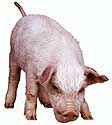
THURSDAY, May 26 (HealthDay News) — Changes in the swine flu virus over the past three decades can be traced, at least in part, to the transportation of live pigs, a new study reports.
The finding stems from an analysis of viruses found in swine in Hong Kong. As pigs were transported from one region to another, the genetic material of the viruses mixed with local viruses, creating new combinations and increasing the diversity of the virus, according to the study, done by a collaboration of researchers from Duke University and the National University of Singapore.
“These results provide important clues into the mechanism of influenza virus evolution in general,” Vijaykrishna Dhanasekaran, an assistant professor specializing in virus evolution at Duke-NUS Graduate Medical School in Singapore, said in a Duke news release.
Although the mutations mean that the number of viruses people are likely to come into contact with has increased, the researchers pointed out that the actual risk to humans is unclear.
“I think the risk of swine-to-human transmission has not increased greatly, but the diversity of swine viruses has increased, as shown in our study,” Dhanasekaran said. “This means that the repertoire of viruses that humans are in contact with every day has increased, and this may lead to a higher likelihood of swine-to-human transmission, although the risk remains unquantified.”
The study, published online May 25 in Nature, examined the epidemiology, genetics and antigenic properties (referring to features on the surface of the virus that pigs and humans develop antibodies against) of swine flu virus in Hong Kong from more than 650 samples taken from swine and more than 800 swine blood specimens.
“It is important to monitor viruses in swine, especially those that can emerge in humans that we do not have antibodies for,” Dhanasekaran said.
More information
The U.S. Centers for Disease Control and Prevention provides detailed information on swine flu.

